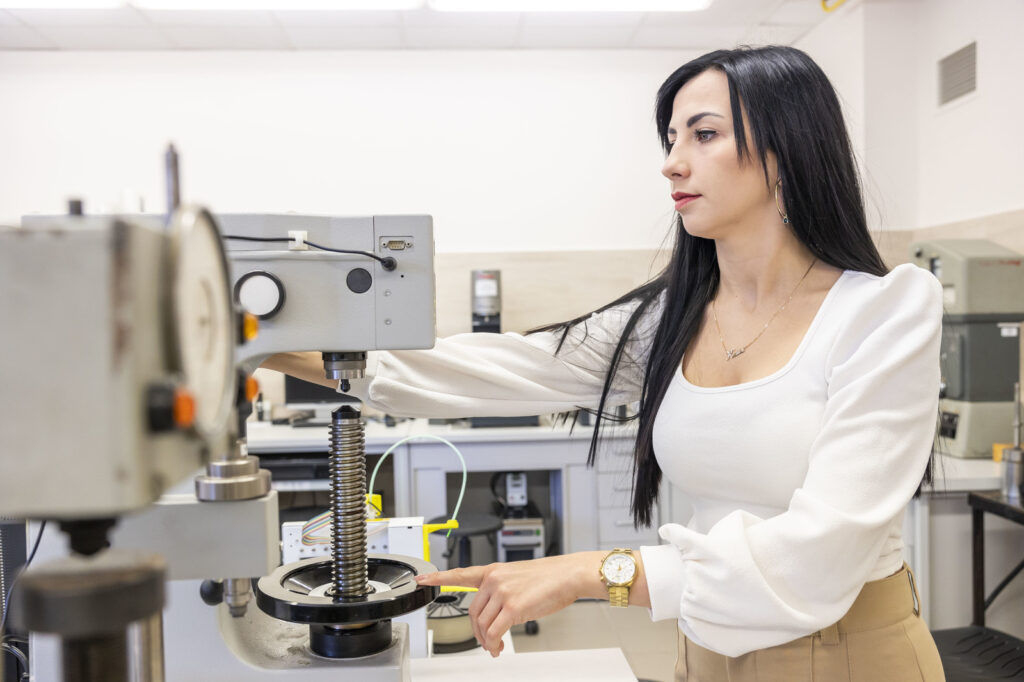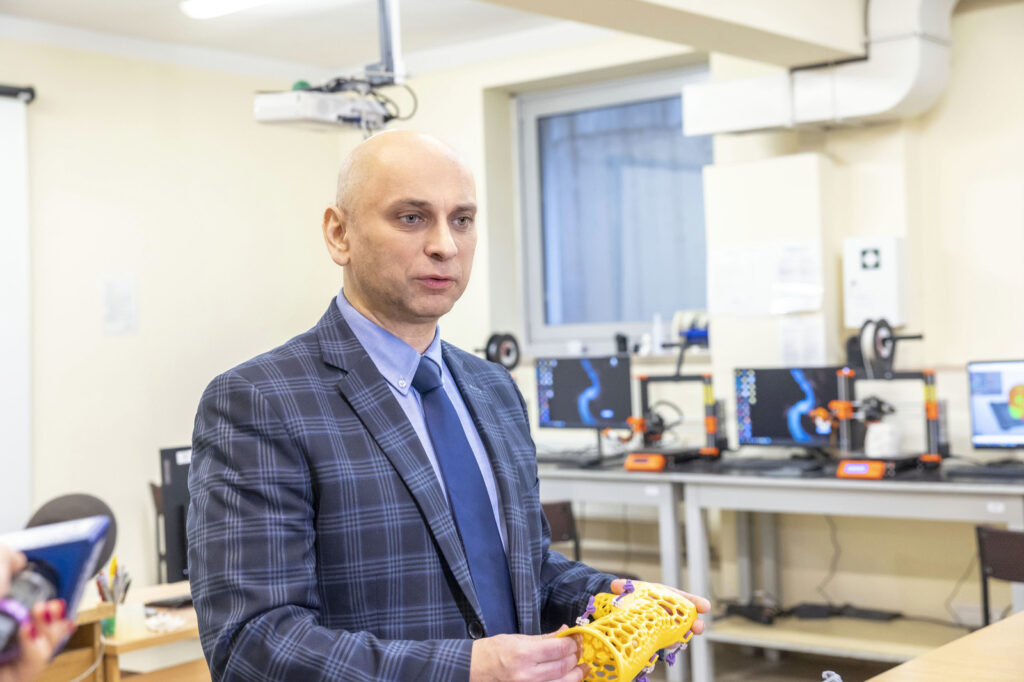Research is based on the latest technologies using, among other things, the digitalisation of medical images and the production of medical models using 3D printing and hybrid manufacturing processes. In the Department of Mechanical Engineering at the Faculty of Mechanical Engineering and Aeronautics, medical models are being created to speed up the planning and execution of complex medical operations. A number of innovative solutions for medical applications have been developed, enabling, among other things, surgical planning, pre-operative training and accelerated recovery and rehabilitation.
Researchers at the Rzeszów University of Technology carry out joint research with staff at the University of Rzeszów in the field of medical engineering in the broadest sense. The research is based on the latest technologies using digitalisation of medical images, processing of numerical data into three-dimensional models and production of medical models using 3D printing and hybrid manufacturing processes.
Medicine-related research
Scientific research related to medicine, health and quality of life are in line with the latest trends in scientific development, and at the same time belong to the area of innovative specialisation of the Podkarpackie voivodeship in terms of improving the quality of life. Research work carried out in inter-university teams makes it possible for patients who require surgery as a result of injuries or lesions, including cancer, to recover more quickly. An important element of the discussed medical engineering processes is imaging diagnostics and medical data analysis, which allows the production of three-dimensional numerical models that are the basis for manufacturing models by 3D printing. The process of data processing and analysis determines the geometric accuracy and localisation of lesions and injuries, additionally allowing the appropriate separation of soft tissues, hard tissues or pathological lesions in order to produce a visual and physical model.
An important element in the medical engineering process is the study of materials and how they can be processed in the various areas of application, from the production of medical visual models by 3D printing, the making of preoperative templates and trainers by hybrid methods, to medical devices that may come into direct contact with the tissues of living organisms. Here, both the processing and strength properties of the materials, as well as specific regulations and approvals, must be taken into account.

K. Bulanda, PhD Eng., Photo B. Motyka
Research teams
The implementation of the research was possible thanks to the cooperation of a number of research teams from the Rzeszów University of Technology and the University of Rzeszów. Several research areas can be distinguished, including orthopaedics, maxillofacial surgery or urology and nephrology. Rzeszów University of Technology has a team of researchers in the field of medical engineering, which includes: in the area of 3D printing and reconstructive engineering – Grzegorz Budzik, BEng, PhD, DSc, ProfTit, Tomasz Dziubek, BEng, PhD, DSc, Assoc. Prof., Sławomir Miechowicz, BEng, PhD, DSc, Assoc. Prof., Łukasz Przeszłowski, BEng, PhD, Paweł Turek, BEng, PhD, Małgorzata Zaborniak, BEng, PhD, Sławomir Wolski, PhD – in the area of material engineering and composites used in medicine – Mariusz Oleksy, BEng, PhD,DSc, ProfTit, and Katarzyna Bulanda, BEng, PhD, from the Department of Polymer Composites at the Faculty of Chemistry. Researchers from Rzeszów University of Technology cooperate with scientific teams from the University of Rzeszów in the following areas, among others: orthopaedics – with the team of Sławomir Snela, MD, PhD, DSc, ProfTit, hydrogel and special dressings – with the team of Artur Mazur, MD, PhD, DSc, ProfTit, facio-maxillofacial surgery – with the team of Bogumił Lewandowski, MD, PhD, DSc, ProfTit, neurosurgery – with the team of Jacek Szczygielski, MD, PhD, DSc, Assoc. Prof., cardiac surgery – with the team of Kazimierz Widenko MD, PhD, DSc, Assoc. Prof., urology and nephrology – with the team of Krzysztof Balawender, MD, PhD, and biochemistry – with the team of Dorota Bartusik-Aebischer, BEng, PhD, DSc, Assoc. Prof. An important link connecting the work of many research teams is the TECHNOMED cluster – technologies in medicine, whose signatories include Rzeszów University of Technology and the University of Rzeszów.
The work of these teams has resulted in the development of many innovative solutions, which have been applied for patent protection, have been the basis for international scientific publications and research projects, and, above all, have made it possible to improve the health and quality of life of many people who are the beneficiaries of these solutions.

Prof. G. Budzik, Photo B. Motyka
Links to websites and interviews:
https://teleexpress.tvp.pl/66372757/druk-3d-wspomaga-lekarzy
https://radio.rzeszow.pl/audycje/drukarki-3d-przyszloscia-medycyny
Articles links:
1) Turek, P., Filip, D., Przeszłowski, Ł., et al.: Manufacturing Polymer Model of Anatomical Structures with Increased Accuracy Using CAx and AM Systems for Planning Orthopedic Procedures. Polymers, 14(11), 2236, 2022. https://doi.org/10.3390/polym14112236
2) Turek, P.: Evaluation of surface roughness parameters of anatomical structures models of the mandible made with additive techniques from selected polymeric materials. Polimery 67(4), 162-167, 2022. https://doi.org/10.14314/polimery.2022.4.4
3) Kroczek, K., Turek, P., Mazur, D., et al.: Characterisation of Selected Materials in Medical Applications. Polymers, 14(8), 1526, 2022. https://doi.org/10.3390/polym14081526
4) Turek, P., Pakla, P., Budzik, G., Lewandowski, B., Przeszłowski, Ł., Dziubek, T., Wolski, S., Frańczak: J.: Procedure Increasing the Accuracy of Modelling and the Manufacturing of Surgical Templates with the Use of 3D Printing Techniques, Applied in Planning the Procedures of Reconstruction of the Mandible. J. Clin. Med. 10, 5525, 2021. https://www.mdpi.com/2077-0383/10/23/5525
5) Turek P., Budzik G.: Estimating the Accuracy of Mandible Anatomical Models Manufactured Using Material Extrusion Methods, Polymers, 13(14), 2271, 2021. https://doi.org/10.3390/polym13142271
6) Turek P., Budzik G., Przeszłowski Ł.: Assessing the Radiological Density and Accuracy of Mandible Polymer Anatomical Structures Manufactured Using 3D Printing Technologies, Polymers, 12(11), 2444, 2020. https://doi.org/10.3390/polym12112444,
7) Turek P., Budzik G., Oleksy M., Bulanda K.: Polymer materials used in medicine processed by additive techniques, Polimery, 65(7-8), s. 510-515, 2020. – DOI:dx.doi.org/10.14314/polimery.2020.7.2
8) Budzik G., Turek P.: The impact of use different type of image interpolation methods on the accuracy of the reconstruction of skull anatomical model, Biomedical Engineering: Applications, Basis and Communications 32(1), 2050008 , 2020. –https://doi.org/10.4015/S1016237220500088
9) Budzik G., Turek P., Dziubek T., Gdula M: Elaboration of the measuring procedure facilitating precision assessement of the geometry of mandible anatomical model manufactured using additive methods, Measurement and Control 53(1-2), s. 181-191, 2020.
https://doi.org/10.1177/0020294019881708
10) Turek P.: Automating the process of designing and manufacturing polymeric models of anatomical structures of mandible with Industry 4.0 convention, Polimery, 64(7-8), s. 522-529, 2019. —–> DOI: dx.doi.org/10.14314/polimery.2019.7.9
11) Budzik G., Turek P.: Improved accuracy of mandible geometry reconstruction at the stage of data processing and modeling, Australasian Physical and Engineering Sciences in Medicine, 41(3), s. 687-695, 2018. —–> DOI:10.1007/s13246-018-0664-5,
12) Budzik G., Turek P., Traciak J.: The influence of change in slice thickness on the accuracy of reconstruction of cranium geometry, Proc IMechE, Part H: J Engineering in Medicine, 231(3), s. 197-202, 2017. —-> https://doi.org/10.1177/0954411916688717


